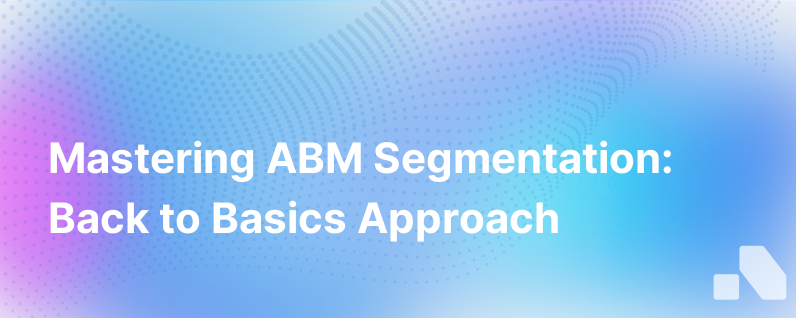
In the world of B2B marketing, Account-Based Marketing (ABM) has transformed how we go to market. It flips the traditional funnel upside down and aligns sales and marketing efforts around exceptionally tailored experiences for a curated list of accounts. However, as with any strategic framework, ABM's success relies on a solid foundation—and that foundation is account segmentation.
ABM segmentation is no nominal task; it requires thoughtful analysis and a firm understanding of your ideal customers. It's not about arbitrary classification but about strategic partitioning that allows you to focus your efforts and resources on the accounts that promise the highest return. Yet, many companies start their ABM programs with complex tools and data strategies, overlooking the basics of segmentation that can make or break their marketing efforts.
Let's realign with the fundamentals of ABM segmentation and understand why it's crucial to get back to these basics.
Understanding ABM Segmentation
Account segmentation in ABM separates target accounts into distinct groups that exhibit similar needs, attributes, or behaviors. This process is essential for several reasons:
- Resource Efficiency: Helps your team focus on high-impact activities.
- Improved Messaging: Allows for more personalized and relevant messaging.
- Enhanced Content Alignment: Ensures that your content resonates with the specific challenges and interests of each segment.
- Sales Alignment: Provides sales teams with precision insights on priority accounts, strengthening their negotiations and conversions.
- Customer Experience: Delivers an experience that feels bespoke to the account, fostering deeper relationships.
Getting Back to Basics
The “back to basics” philosophy underscores the importance of simplicity and ensuring foundational processes are in place before advancing to more sophisticated ABM tactics. Here's how to get started:
1. Define Your Ideal Customer Profile (ICP)
The very first step is to define your ICP. Without it, your ABM efforts will not be laser-focused. Evaluate your best customers, examine shared characteristics, and look at the broader market to understand where your solution fits best. Elements of a robust ICP include:
- Industry or vertical
- Company size and structure
- Budget or revenue
- Pain points your solution addresses
- Geographical location
- Technological maturity
2. Conduct Tiering Your Accounts
After defining your ICP, begin tiering your accounts into A, B, and C categories. This tier system enables you to allocate resources optimally.
- Tier A: These are your dream accounts—the ones with the highest revenue potential and best fit for your solution. They require hyper-personalization and the most significant investment in terms of content and outreach.
- Tier B: These accounts might not have as high a potential as Tier A but still promise significant value and fit well with your product or service.
- Tier C: These are the accounts that you will engage with more scalable, less personalized tactics.
3. Collect and Cleanse Your Data
Reliable data is the cornerstone of effective ABM segmentation. Ensure your account data is up-to-date, accurate, and as comprehensive as possible. It should include firmographic information, relevant technologies in use, business challenges, and purchase history.
4. Utilize Behavioral Data
Behavioral data such as content downloads, webinar participation, and email engagement provide insights into accounts’ interests and intent. Factoring this into your ABM segmentation will ensure your strategies are aligned with current account behaviors.
5. Create Value-Based Segments
Segment accounts based on the kind of value they seek from your solutions. Why? Because understanding their desired outcomes helps in crafting messages that resonate powerfully. Is the account seeking efficiency, growth, innovation, or reputational enhancement?
6. Map the Stakeholder Ecosystem
Especially in Tier A and B accounts, identify all stakeholders involved in the buying process from influencers to decision-makers. Understand their distinct needs, pain points, and the value they personally seek, allowing you to tailor your messaging accordingly.
7. Select Criteria for Dynamic Segmentation
Your ABM program should not be rigid. Use dynamic segmentation criteria that can adapt as accounts grow and evolve. This could be based on engagement stages, lifecycle changes, or other key behaviors.
8. Test and Optimize
Once your segments are in place, continuously test and optimize. Are you seeing the engagement you expected? Is your content hitting the mark? As your ABM program matures, so should your understanding of your segments and how best to engage them.
9. Ensure Cross-Functional Collaboration
Involve stakeholders from sales, marketing, customer success, and even product development in creating and refining your segments. This collaboration bridges gaps in understanding and ensures a cohesive approach.
Conclusion
With the complexity of marketing strategies rapidly increasing, it can be refreshing to return to fundamentals. ABM segmentation is where the rubber meets the road for your ABM strategy, so taking the time to get it right will set the stage for the kind of targeted, efficient outreach that can drastically improve performance.
By going back to basics, you can build a strong platform for advanced ABM strategies. Embedding these fundamentals into your ABM program ensures a robust, laser-focused approach that aligns with your goals and delivers the highest impact.
Remember, the sophistication of your ABM tools and tactics can never replace the necessity of well-thought-out segmentation. Starting simple, and refining as you go, allows for an agile and effective approach to modern B2B marketing.